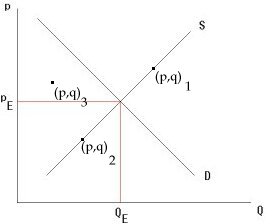 The central
static IT in supply and demand theory is (suffix "s1" stands for statics 1):
The central
static IT in supply and demand theory is (suffix "s1" stands for statics 1): Bert hamminga DME applied to Supply and Demand 000213 Supply and Demand
Statics: The Definition Of Equilibrium. Comparative Statics Dynamics
 The central
static IT in supply and demand theory is (suffix "s1" stands for statics 1):
The central
static IT in supply and demand theory is (suffix "s1" stands for statics 1):
ITs1: there is one and only one equilibrium point ("existence and uniqueness").
The basic conditions Ci in the PET1:
PETs1: {C1,C2,...,Ck} � ITs1
are:
HC1: q = S (p)
HC2: q = D (p)
These are HC conditions. They are conditions on (p,q)'s. Some (p,q)'s satisfy the
condition q=S(p), like (p,q)s1 and (p,q)s3, others do not,
like (p,q)s2.
C1 and C2 reflect the economist's basic idea that under
"perfect" conditions (perfect information, a single homogenous good with no
substitutes of complementary goods etc. etc.), the equilibrium is a value of (p,q)
satisfying C1 and C2.
These HC conditions are insufficient to proove IT. There are many exceptions.You need
special conditions to exclude the exceptions. (This example is pure Hard Core analysis: it
has no application conditions as usually found in DME). These are examples of S-D pairs
that we do not want (Philosopher of Science Imre Lakatos calls such undesired
counterexamples monsters):
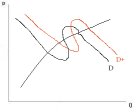 M Monster 1 (left): If
the supply curve, like the black D or the red D+ is wave-shaped like in the picture right,
you can have up to three equilibrium points. A rough measure to exclude such problems is
to linearize like in special condition SC1:
M Monster 1 (left): If
the supply curve, like the black D or the red D+ is wave-shaped like in the picture right,
you can have up to three equilibrium points. A rough measure to exclude such problems is
to linearize like in special condition SC1:
SCs1: q= S(p) = ap+b, q= D(p) = cp+d
When a problem is too complex, linearization is often the first step in deductive model exploration. In later stages, one tries to drop this strong condition.
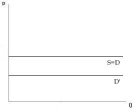 M Monster 2 (right): If S=D, there are infinitely
many equilibrium points.
M Monster 2 (right): If S=D, there are infinitely
many equilibrium points.
If S and D' are parallel lines, you have no equilibrium point. Under linearity, monster 1
can be excluded by the special condition SC2 ("<>" means unequal):
SCs2: a<>c
.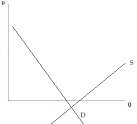 M Monster 3 (right): You do not want an
equilibrium at a negative price. Under the linear equations introduced to bar monster 1,
S=D iff ap+b=cp+d. So the special condition SC3 we need to introduce is:
M Monster 3 (right): You do not want an
equilibrium at a negative price. Under the linear equations introduced to bar monster 1,
S=D iff ap+b=cp+d. So the special condition SC3 we need to introduce is:
SCs3: p = (d-b) / (a-c) > 0
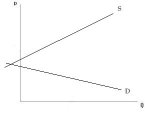 M Monster 4 (left): You do not want an
equilibrium at a negative quantity. Under the linear equations introduced to bar monster 1
M Monster 4 (left): You do not want an
equilibrium at a negative quantity. Under the linear equations introduced to bar monster 1
SCs4: q = (ad-cb) / (a-c) > 0
Summarizing: we may at first have thought that existence and uniqueness of equilibrium on a single homogenous market with no substitutes, nor complementary goods under perfect information etc. etc. was pretty obvious. We ended up with linearizing, a very strong special condition SC1, and special conditions SC2, SC3 and SC4 on the values for the parameters a,b,c and d in order to bar monsters 2, 3 and 4. This is sufficient for existence and uniqueness. The PET runs like this:
PETs1: {HC1,HC2,SCs1,SCs2,SCs3,SCs4}� ITs1
After establishing a first version of such a PET as just explained, DME
Comparative statics Statics Dynamics
 Comparative static
analysis of changes: IT concern whether new equilibrium values (p,q) will be higher or
lower if some exogenous variable t gets higher or lower. So, IT state that
Comparative static
analysis of changes: IT concern whether new equilibrium values (p,q) will be higher or
lower if some exogenous variable t gets higher or lower. So, IT state that
Dp / Dt
is positive (or negative), and the possibly the same with Dq / Dt.
Those are classical examples of a comparative static theorems:
ITcs1: Dp / Dt > 0
ITcs2: Dq / Dt > 0
If in the neighbourhood where (p,q) is going to move as a result of the t-shock the
following special conditions hold (for the explanation click here):
SCcs1: dS / dp > 0 (S is upward sloping to the right)
SCcs2: � D / � t > 0 (Demand rises if, ceteris paribus, t rises)
SCcs3: Equilibrium exists and is unique (our statical IT from the previous paragraph!)
That means pE and QE move in the same direction as t, on warmer days, more ice is sold more expensively. So we have two PET's:
PETcs1: {HC1,HC2,SCcs1,SCcs2,SCcs3,}� ITcs1
PETcs2: {HC1,HC2,SCcs1,SCcs2,SCcs3}� ITcs2
Those are classical examples of a comparative static theorems.
In statics we prefer equilibrium to exist and to be unique because that is a very useful
condition to use in comparative statics. Multiple (not unique) equilibria like in Monster 1 cause serious problems: If before the t-shock the
(p,q) equilibria are possible, and after the t-shock again three, from where to where
would the equilibrium-(p,q) go? There are 9 possibilities, not likely al to yoield
the same sign for Dp / Dt
or Dq / Dt. You're not
likely to deduce any interesting theorem. But linearization, as we did here, is an
unneceesarily heavy poison for the monster. Weaker conditions will do. We shall not go
into the details. These examples serve the purpose to make clear to you how DME goes about
in general.
Dynamics: the Path to Equilibrium: Statics Comparative Statics
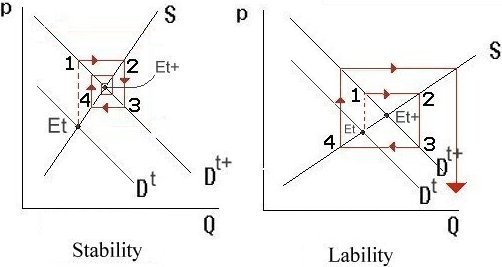
In initial situation 1, suppliers face a demand at which they had wished to supply a quantity according to point 2. They go home dissatisfied and make new plans for the next day. The second day, they supply a quantity according to 2, but discover that, at that quantity, they can only clear their market if they sell sell at a price according to 3. The third day, they sell a quantity belonging to their supply curve at the price of 3, that is, according to 4. Whether or not supplier's decisions will thus approach market equilibrium, depends on the slope of S relative to D. In the right hand side graph, these slopes are such that the market gets out of hand ("explodes").
The aims of dynamics are to find out
If stability is an IT (called ITd1), what would be the special conditions for stability in this case? Under what general conditions do we get result like the left had side graph, under what conditions do we get results like the right hand side graph? In the case of linear S and D, the special condition SCd1 on the linear functions S and D is:
SCd1: dS/dp < - �D/�p
As a memory aid remember: to avoid an explosion, suppliers S should not overreact on demanders D. Summarized in the metalanguage of DME:
PETd1: {HC1,HC2,SCd1}� ITd1
Dynamics needs comparative statics, comparative statics needs statics
Finally: you have now seen that for comparative statics you need the basic statical results of existence and uniqueness. For dynamics: to follow the time paths towards the new equilibrium comparative statics should first tell you to what final destination the time path is leading.